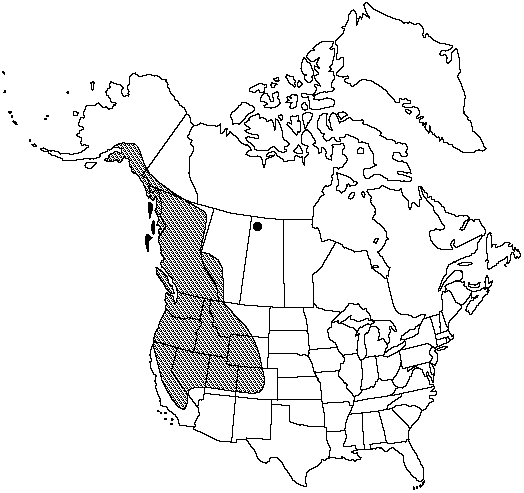familyDryopteridaceae
genusWoodsia
speciesWoodsia scopulina
subspeciesWoodsia scopulina subsp. scopulina
Difference between revisions of "Woodsia scopulina subsp. scopulina"
Endemic
Treatment appears in FNA Volume 2.
FNA>Volume Importer |
imported>Volume Importer |
||
| (7 intermediate revisions by 2 users not shown) | |||
| Line 3: | Line 3: | ||
|accepted_authority=D. C. Eaton | |accepted_authority=D. C. Eaton | ||
|publications= | |publications= | ||
| + | |special_status={{Treatment/ID/Special_status | ||
| + | |code=E | ||
| + | |label=Endemic | ||
| + | }} | ||
|basionyms= | |basionyms= | ||
|synonyms= | |synonyms= | ||
| Line 12: | Line 16: | ||
}}<!-- | }}<!-- | ||
| − | --><span class="statement" id="st- | + | --><span class="statement" id="st-undefined" data-properties=""><b>Scales </b>of stems and petiole bases usually concolored or with a few isolated, dark, occluded cells, scales ovate-lanceolate. <b>Pinnae</b> with longest hairs composed of 2–5 cells. <b>Indusial</b> segments narrow, often filamentous distally. <b>Spores</b> averaging 42–50 µm. <b>2n</b> = 76.</span><!-- |
-->{{Treatment/Body | -->{{Treatment/Body | ||
| + | |phenology=Sporulating summer–fall. | ||
|habitat=Cliffs and rocky slopes, found on variety of substrates including both granite and limestone | |habitat=Cliffs and rocky slopes, found on variety of substrates including both granite and limestone | ||
|elevation=100–4000 m | |elevation=100–4000 m | ||
|distribution=Alta.;B.C.;Sask.;Yukon;Alaska;Calif.;Colo.;Idaho;Mont.;Nev.;Oreg.;Utah;Wash.;Wyo. | |distribution=Alta.;B.C.;Sask.;Yukon;Alaska;Calif.;Colo.;Idaho;Mont.;Nev.;Oreg.;Utah;Wash.;Wyo. | ||
| − | |discussion=<p>Woodsia scopulina subsp. scopulina is known to hybridize with subsp. laurentiana at localities where the two grow in close proximity. The resultant triploids have malformed spores and appear to be sterile.</p> | + | |discussion=<p><i>Woodsia scopulina </i>subsp.<i> scopulina</i> is known to hybridize with <i></i>subsp.<i> laurentiana</i> at localities where the two grow in close proximity. The resultant triploids have malformed spores and appear to be sterile.</p> |
|tables= | |tables= | ||
|references= | |references= | ||
| Line 27: | Line 32: | ||
-->{{#Taxon: | -->{{#Taxon: | ||
name=Woodsia scopulina subsp. scopulina | name=Woodsia scopulina subsp. scopulina | ||
| − | |||
|authority=D. C. Eaton | |authority=D. C. Eaton | ||
|rank=subspecies | |rank=subspecies | ||
| Line 34: | Line 38: | ||
|basionyms= | |basionyms= | ||
|family=Dryopteridaceae | |family=Dryopteridaceae | ||
| + | |phenology=Sporulating summer–fall. | ||
|habitat=Cliffs and rocky slopes, found on variety of substrates including both granite and limestone | |habitat=Cliffs and rocky slopes, found on variety of substrates including both granite and limestone | ||
|elevation=100–4000 m | |elevation=100–4000 m | ||
| Line 40: | Line 45: | ||
|publication title= | |publication title= | ||
|publication year= | |publication year= | ||
| − | |special status= | + | |special status=Endemic |
| − | |source xml=https:// | + | |source xml=https://bitbucket.org/aafc-mbb/fna-data-curation/src/2e0870ddd59836b60bcf96646a41e87ea5a5943a/coarse_grained_fna_xml/V2/V2_289.xml |
|genus=Woodsia | |genus=Woodsia | ||
|species=Woodsia scopulina | |species=Woodsia scopulina | ||
|subspecies=Woodsia scopulina subsp. scopulina | |subspecies=Woodsia scopulina subsp. scopulina | ||
| − | |||
| − | |||
| − | |||
| − | |||
| − | |||
| − | |||
| − | |||
| − | |||
| − | |||
}}<!-- | }}<!-- | ||
-->[[Category:Treatment]][[Category:Woodsia scopulina]] | -->[[Category:Treatment]][[Category:Woodsia scopulina]] | ||
Latest revision as of 21:22, 5 November 2020
Scales of stems and petiole bases usually concolored or with a few isolated, dark, occluded cells, scales ovate-lanceolate. Pinnae with longest hairs composed of 2–5 cells. Indusial segments narrow, often filamentous distally. Spores averaging 42–50 µm. 2n = 76.
Phenology: Sporulating summer–fall.
Habitat: Cliffs and rocky slopes, found on variety of substrates including both granite and limestone
Elevation: 100–4000 m
Distribution

Alta., B.C., Sask., Yukon, Alaska, Calif., Colo., Idaho, Mont., Nev., Oreg., Utah, Wash., Wyo.
Discussion
Woodsia scopulina subsp. scopulina is known to hybridize with subsp. laurentiana at localities where the two grow in close proximity. The resultant triploids have malformed spores and appear to be sterile.
Selected References
None.
Lower Taxa
None.